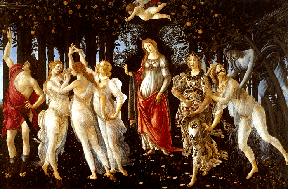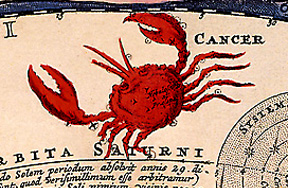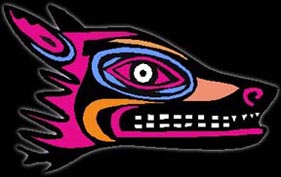Painting (c.1610) of Nicolas Poussin (1594-1665) entitled "The Triumph of Neptune and
Amphitrite."
Click on image for full size
Image courtesy of the Philadelphia Museum of Art: The George W. Elkins Collection.
Amphitrite
Amphitrite was one of the fifty Nereids, the attendants of the sea-god Poseidon. Poseidon
(Neptune) had fallen in love with Amphitrite after seeing her dancing on the island of Naxos. Amphitrite rejected his advances with repugnance, and fled to the
Atlas Mountains to escape him. However, Poseidon sent a messenger after her, one Delphinus, who pleaded so well Poseidon's cause that the Nereid accepted to marry the sea god.
For gratitude, Poseidon placed the image of the Dolphin among the stars to form the constellation Dolphinus, the Dolphin. Amphitrite and Poseidon had three children: Triton, Rhodes, and Benthesicyme.
The principal moon of the planet Neptunewas named in 1846 by William Lassell after Triton. The island of Rhodes was named after the daughter of Poseidon ad Amphitrite. The next largest moon of the planet Neptune was discovered by Gerard P. Kuiper in 1949 and named Nereid after the attendants of the sea god, the Nereids.
Notwithstanding his persistence in marrying Amphitrite, Poseidon had many love affairs with goddesses, nymphs and mortal women making Amphitrite unhappy. She especially loathed his infatuation with a Scylla. By throwing magical herbs into Scylla's bathing pool, Amphitrite changed her rival into a barking monster with six heads and twelve feet.
You might also be interested in:

Ahsonnutli was the sky father and chief deity of the Navajo Indians. He created heaven, Earth, and the sky. Each of the four cardinal directions was supported by a giant. Each direction was also associated
...more
Amphitrite was one of the fifty Nereids, the attendants of the sea-god Poseidon. Poseidon (Neptune) had fallen in love with Amphitrite after seeing her dancing on the island of Naxos. Amphitrite rejected
...more
Aphrodite was the Greek goddess of love and beauty. She was known to the Romans as Venus. There were actually two different Aphrodites, one was the daughter of Uranus, the other the daughter of Zeus and
...more
In Greek mythology, Apollo was the son of Jupiter(in Greek Zeus) and Leto (Letona). He was the god of the Sun, logic, and reason, and was also a fine musician and healer. Leto travelled all over Greece
...more
According to an ancient Greek legend, the figure of a gigantic crab was placed in the nighttime sky by the goddess Hera to form the constellation Cancer. Hera was the jealous wife of the sky god, Zeus.
...more
In the Northern Hemisphere sky is the constellation Cepheus, king of Ethiopia, and that of his wife Cassiopeia. Cassiopeia claimed that she and her daughter Andromeda were more beautiful than the sea nymphs,
...more
According tho the Navajo mythology, the Milky Way was created by the misbehavior of the mischievous deity, Coyote. When the world was created, the Holy People gathered around Black God to place the stars
...more














